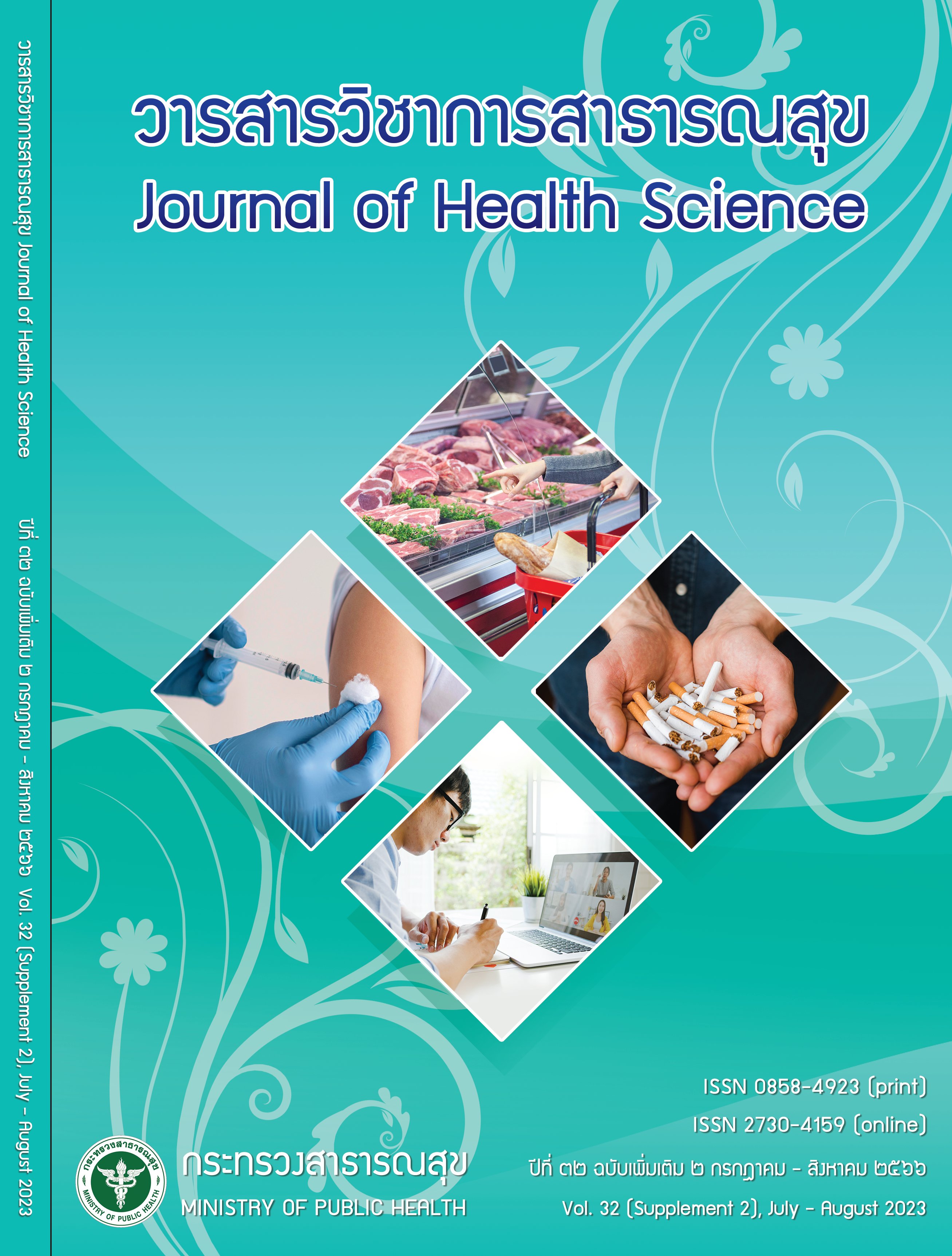ประสิทธิผลของการรักษาระหว่างเครื่องกระตุ้นประสาทส่วนปลายด้วยแม่เหล็กไฟฟ้ากับการลงเข็มในผู้ป่วยกลุ่มอาการปวดกล้ามเนื้อและพังผืดคอ
คำสำคัญ:
เครื่องกระตุ้นประสาทส่วนปลายด้วยแม่เหล็กไฟฟ้า, การลงเข็ม, กลุ่มอาการปวดกล้ามเนื้อและพังผืดคอบทคัดย่อ
กลุ่มอาการปวดกล้ามเนื้อและพังผืด (myofascial pain syndrome, MPS) พบบ่อยในผู้ป่ วยทีมาด้วยอาการปวดคอ ่ การรักษาโดยการลงเข็ม (dry needling, DN) เป็นที่นิยมและยอมรับในการรักษาผู้ป่ วย MPS และปัจจุบันเริ่มมีการ รักษาผู้ป่ วย MPS ด้วยเครื่องกระตุ้นประสาทส่วนปลายด้วยแม่เหล็กไฟฟ้ า (PMS) มากขึ้น งานวิจัยนี้มีวัตถุประสงค์ เพื่อเปรียบเทียบประสิทธิผลของสองเทคนิคนี้ ศึกษาในอาสาสมัคร MPS คอจำนวน 44 คน โดยสุ่มเป็น 2 กลุ่ม คือ กลุ่ม PMS และกลุ่ม DN วัดค่ามัธยฐานระดับคะแนนความเจ็บปวด (visual analog scale, VAS) และคะแนนดัชนี วัดความบกพร่องความสามารถของคอฉบับภาษาไทย (NDI-TH) ในช่วงก่อนการรักษา หลังการรักษาที่ 2 และ 4 สัปดาห์ ผลการศึกษาพบว่า ทั้งกลุ่ม PMS และกลุ่ม DN มีค่ามัธยฐานระดับคะแนน VAS และ NDI-TH ลดลงที่หลัง การรักษา 2 และ 4 สัปดาห์อย่างมีนัยสำคัญทางสถิติ และเมื่อเทียบการเปลี่ยนแปลงของคะแนนระหว่างกลุ่ม PMS และ DN พบว่า ค่ามัธยฐานคะแนน VAS และ NDI-TH ไม่แตกต่างกันอย่างมีนัยสำคัญทางสถิติ ดังนั้นงานวิจัยนี้ พบว่า PMS ลดอาการปวดและเพิ่มความสามารถในการทำกิจกรรมในผู้ป่ วย MPS คอได้ไม่แตกต่างกับการรักษา โดย DN
Downloads
เอกสารอ้างอิง
Michael J, Justin J. Common neck problems. In: Braddom RL, editor. Physical Medicine and Rehabilitation. 5th ed. Philadelphia: Elsevier; 2011. p. 687-710.
Childs JD, Fritz JM, Piva SR, Whitman JM. Proposal of a classification system for patients with neck pain. J Orthop Sports Phys Ther 2004;34(11):686-96.
Childs JD, Cleland JA, Elliott JM, Teyhen DS, Wainner RS, Whitman JM, et al. Neck pain: Clinical practice guidelines linked to the International Classification of Functioning, Disability, and Health from the Orthopedic Section of the American Physical Therapy Association. J Orthop Sports Phys Ther 2008;38(9):1-34.
Ferrante FM, Bearn L, Rothrock R, King L. Evidence against trigger point injection technique for treatment of cervicothoracic myofascial pain with botulinum toxin type A. Anesthesiology 2005;103(2):377-83.
Travell JG, Simons DG. Myofascial pain and dysfunction: the trigger point manual. 2nd ed. Baltimore: Williams and wilkins; 1999.
อานนท์ พงศ์ธรกุลพานิช, พรฑิตา ชัยอำนวย, ไพจิตต์ อัศวธนบดี, อุรุยา ก้องเกียรติงาม. Myofascial pain syndrome in Thai community. จุลสารรูมาติสซั่ม 2538;4(1):2-9.
Mehul J, Vikramjeet S, Shawnjeet S. Myofascial pain syndrome: a treatment review. Pain Ther 2013;2(10):21– 36.
Lewit K. The needle effect in the relief of myofascial pain. Pain 1979;6(1):83-90.
Gunn CC, Milbrandt WE, Little AS, Mason KE. Dry needling of muscle motor points for chronic low back pain. Spine 1980;5(3):279-91.
Tough EA, White AR, Cummings TM, Richards SH, Campbell JL. Acupuncture and dry needling in the management of myofascial trigger point pain. Eur J Pain 2009;13(1):3-10.
Pujol J, Pascual A, Dolz C, Delgado E, Dolz JL, AldomaJ. The effect of repetitive magnetic stimulation on localized musculoskeletal pain. Neuroreport 1998;9(8):1745-8.
Smania N, Corato E, Fiaschi A, Pietropoli P, Aglioti SM, Tinazzi M. Therapeutic effects of peripheral repetitive magnetic stimulation on myofascial pain syndrome. Clin Neurophysio 2003;114(2):350-8.
Smania N, Corato E, Fiaschi A, Pietropoli P, Aglioti SM, Tinazzi M. Repetitive magnetic stimulation. J Neuro 2005;252(3):307-14.
Krause P, Foerderreuther S, Straube A. Effects of conditioning peripheral repetitive magnetic stimulation in patients with complex regional pain syndrome. Neurol Res 2005;27(4):412-7.
Lo YL, Fook-Chong S, Huerto AP, George JM. A randomized placebo-controlled trial of repetitive spinal magnetic stimulation in lumbosacral spondylotic pain. Pain 2011;12(7):1041-5.
Masse H, Flamand VH, Moffet H, Schneider C. Peripheral neuro stimulation and specific motor training of deep abdominal muscles improve posturomotor control in chronic lowback pain. Clin J Pain 2013;29(9):814-23.
Leung A, Fallah A, Shukla S. Transcutaneous magnetic stimulation (TMS) in alleviating post-traumatic peripheral neuropathic pain States. Pain 2014;15(7):1196-9.
Struppler A, Binkofski F, Angerer B, Bernhardt M, Spiegel S. A fronto-parietal network is mediating improvement of motor function related to repetitiveperipheral magnetic stimulation. Neuro Image 2007; 36(2):174-86.
Rossi S, Hallett M, Rossini PM, Pascual A, Safety of TMS Consensus Group. Safety, ethical considerations, and application guidelines for the use of transcranial magnetic stimulation in clinical practice and research. Clin Neurophysiol 2009;120(12):2008-39.
Krewer C, Hartl S, Müller F, Koenig E. Effects of repetitive peripheral magnetic stimulation on upper-limb spasticity and impairment in patients with spastic hemiparesis: a randomized, double-blind, sham-controlled study. Arch Phys Med Rehabil 2014;95(6):1039-47.
Baek J, Park N, Lee B, Jee S, Yang S, Kang S. Effects of repetitive peripheral magnetic stimulation over vastus lateralis in patients after hip replacement surgery. Ann Rehabil Med 2018;42(1):67-75.
Momosaki R, Abo M, Watanabe S, Kakuda W, Yamada N, Kinoshita S. Repetitive peripheral magnetic stimulation with intensive swallowing rehabilitation for poststroke dysphagia. Neuromodulation 2015;18(7):630- 4.
Khedr E, Ahmed M, Alkady E, Mostafa M, Said H. Therapeutic effects of peripheral magnetic stimulation on traumatic brachial plexopathy. Neurophysiol Clin 2012; 42(3):111-8.
Lim Y, Song J, Choi E, Lee J. Effects of repetitive peripheral magnetic stimulation on patients with acute low back pain. Ann Rehabil Med 2018;42(2):229-38.
Massé H, Beaulieu L, Preuss R, Schneider C. Repetitive peripheral magnetic neurostimulation of multifidusmuscles combined with motor training influences spine motor control and chronic low back pain. Clin Neurophysiol 2017;128(3):442-53.
Bernard R. Fundamentals of biostatistics. 5th ed. Massachusetts: Duxbury Publishing; 2000.
Dragana Z, Krasimira K. Repetitive peripheral magnetic stimulation as pain management solution in musculoskeletal and neurological disorders. Int Physiother 2016;3(6);671-75.
Takin L, Akarsu S, Cakar E, Durmus O. The effect of dry needling in the treatement of myofascial pain syndrome. Clin Rheumatol 2013;32(3):309-15.
Ostelo RW, de Vet HC. Clinically important outcomes in low back pain. Best Pract Res Clin Rheumatol 2005; 19(4):593-607.
Vernon H, Mior S. The neck disability index. JMPT 1991;14(7):409-15.
Uthaikhup S, Paungmali A, Pirunsan u. Validation of Thai versions of the neck disability index and neck pain and disability scale in patients with neck pain. Spine 2011;36(21):1415-21.
Luksanapruksa P, Wathana-apisit T, Wanasinthop S, Sanpakit S, Chavasiri C. Reliability and validity study of a Thai version of the neck disability index in patients with neck pain. J Med Assoc Thai 2012;95(5):681-8.
Hong CZ. Lidocaine injection versus dry needling to myofascial trigger point. The importance of the local twitch response. American journal of physical medicine rehabilitation 1994;73(4):256-63.
ดาวน์โหลด
เผยแพร่แล้ว
วิธีการอ้างอิง
ฉบับ
บท
การอนุญาต

This work is licensed under a Creative Commons Attribution-NonCommercial-NoDerivatives 4.0 International License.



